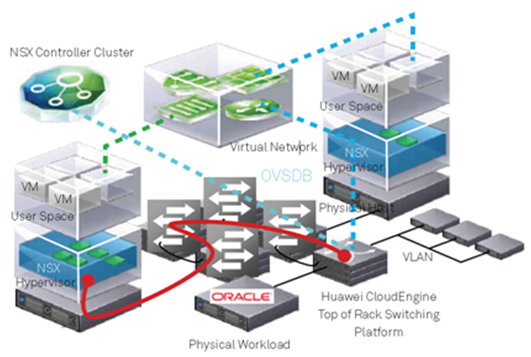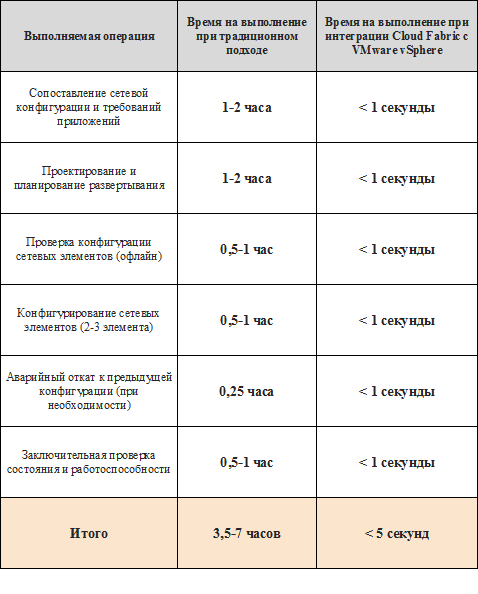Advantages of SDN: on the example of VMware vSphere integration with Huawei Cloud Fabric

Today we will talk about why in recent years the topics of developing cloud technologies, resource virtualization and building software-defined networks have become popular.
And we will try to understand concrete examples, what real benefits are hidden behind the “information noise” around cloud computing and the virtualization of anything and everything, and what advantages you can gain by being on the crest of a wave of actively developing technologies.
Sounds interesting. And what are we talking about?
The question is reasonable. Here and now we will talk about building software-defined networks, known by the abbreviation SDN (from the English Software Defined Networking).
')
In short, SDN is a form of network virtualization.
The main feature of these networks is that the level of their control is separated from data transmission devices and is implemented by software.
It is important to know three things about software defined networks:
- data transfer and data management processes are separated;
- network management is centralized using unified software
- physical network resources virtualization is required.
Why is SDN paid so much attention? The question will disappear by itself if you look at the areas of their application:
- infrastructure cloud services, especially in cases where it is necessary to quickly allocate virtual resources to consumers automatically;
- Data center;
- Internet of Things (IoT).
The theory is clear. Where is the profit?
Profit - in savings.
First, the savings in capital expenditures, as well as the use of cloud technologies: the purchase of servers and network equipment, ensuring a continuous work process, etc.
Secondly, reduction of time for the deployment of additional services and applications in the data center operated by you, as well as the allocation of additional virtual network resources.
Thirdly, reduction of labor costs for network maintenance (due to centralization and automation of management on the program controller) and for all the same deployment of new applications.
And finally, increasing the efficiency of network resource utilization due to dynamic control and almost instantaneous response to the increase in demand for computing power.
Actually, these are the main aspects that are the reasons for the active growth of the SDN market in recent years.
On paper, everything is smooth. Are there examples of use?
Where do without them!
As an example, consider the use of the Huawei Cloud Fabric platform for building software-defined networks for data centers.
Or rather, its integration with the VMware vSphere virtualization platform. The integration of Huawei Cloud Fabric with VMware vSphere is just a vivid demonstration of the possibility of drastically reducing the time and labor required to deploy new services and applications in the data center.
Huawei Cloud Fabric? What is it?
The Huawei Cloud Fabric for SDN data center platform is based on the Huawei CloudEngine switch series. One of the many distinguishing features of the CloudEngine switchboard family is the ability to directly integrate with the VMware environment via a network virtualization controller (VMware NSX) using the OpenVSwitch Database (OVSDB) protocol.
Due to this, the management processes, planning and configuration of the network infrastructure can be carried out by vSphere own means. In addition, such a connection allows the hardware platforms of the network infrastructure to work closely with the computing infrastructure, which provides extremely simple, connected management of computing and network resources when creating, moving or deleting virtual machines.

Integration between NSX VMware vSphere controller and Huawei CloudEngine switching platforms using OVSDB
This level of integration and automation drastically reduces the time, resources, labor, and operational costs associated with deploying new services, optimizing resources, and disaster recovery in an environment that uses the VMware virtualization platform.
Huawei Cloud Fabric provides a significant reduction in time and simplification of the procedure for launching new services on the market, up to the level of the “self-service” model. As a result, data center IT resources may cease to function as a “cost center” and transform their role into a “business accelerator” of the digital era.
And how to integrate? Instructions attached?
We thought about everything.
Integration with Cloud Fabric is implemented by implementing it into the VMware vSphere operating environment through the vSphere network virtualization API. Information about the status, profile, association of a virtual network segment with specific virtual machines and changes in them in real-time mode are transmitted directly by the vSphere SDN controller to the CloudEngine switches.
The integration between the CloudEngine data center switchboard family and the vSphere API-level gives IT administrators a uniform, simple and well-maintained support solution for automating the VMware cloud without requiring any changes to the existing VMware environment.
It looks easy ... And how useful?
The functionality resulting from the integration of Cloud Fabric with VMware vSphere provides significant gains in the following aspects:
- simplified deployment of services and applications;
- reducing the time required to create and optimize network resource settings;
- reduction of operating, administrative and logistic overhead costs;
- reducing the number of errors in deployment and configuration.

Service Deployment Cycle
The figure above shows typical network operation procedures performed when a new service or application is deployed; in a traditional human network, these works are performed mainly in manual mode. In such manual repetitive procedures, the total deployment time and the level of errors is determined by the human factor. Automation achieved through integration with vSphere, based on the powerful capabilities of SDN, can significantly speed up this cycle and reduce the likelihood of errors.
In addition, integration with VMware vSphere provides the following direct benefits:
- shorter “learning curve” for operational personnel: when using network virtualization tools and a vSphere controller, all aspects of operation are consistent with each other and are within the framework of the VMware concept;
- management of computing, network and storage resources is tied to a “single control panel”: coordination and “orchestration” of all data center resources is carried out centrally on a single platform - VMware vSphere;
- Maximize the effectiveness of existing investments while providing a flexible and scalable hardware-optimized SDN solution based on existing VMware vSphere infrastructure and NSX Controller.
Let's take a look at the specific numbers - time reduction, which leads you to a real savings in the operational costs of the data center.
The table below shows a typical example of a generally accepted work cycle (for the best case), which can occur hundreds, if not thousands, of a year. Depending on the size of the network, the size of the company, and the number of services and applications deployed during the year, the actual savings can be significantly greater:

Reasoning in terms of the speed with which new services are introduced, it can be said that, in manual mode, the typical preparation period takes from one day to two weeks.
Against the background of an industry-wide, three-day manual service deployment time, the near real-time performance of SDN systems like Huawei Cloud Fabric and VMware vSphere provides previously unavailable immediate self-service capabilities.
The ability to quickly configure, deploy, and deliver new services and services enables corporate IT services in any industry to create competitive advantages in the areas of user experience, customer interaction, business intelligence, operations, and logistics.
One ... two ... three ... sold!
The target idea of integrating a network infrastructure with a VMware vSphere orchestrator and deploying cloud services through a single system is the implementation of an end-user self-service model.
This model allows an enterprise to reduce costs and time to launch new applications or organize disaster recovery. And an automation and process simplification strategy allows your IT staff to get rid of routine configuration tasks and more efficiently use their time.
In addition, the integration of the SDN platform with VMware vSphere bridges the gap between network and computing functions, which is a key factor in promoting the private cloud in the corporate market.
Source: https://habr.com/ru/post/324990/
All Articles